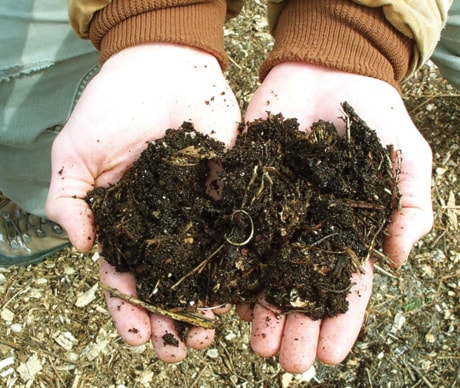Soil is the most important component of the garden. Gardens with a rich, soft humus soil are more likely to produce lush, healthy plants. Poor or marginal soil will grow a garden but it takes more work and doesn’t achieve the same results.
For the majority of plants to look their best, they must have access to a continuous supply of nutrients. While it is possible to supply artificial nutrients by using chemical fertilizer, it is impossible to duplicate natures own reserves.
In nature, soil nutrients are renewed each year through decomposing top growth. Gardeners could leave top growth to decompose, but it would not be pleasing to the eye. An alternative is to add decomposed organic mater, compost or manure to the soil on a regular basis.
Composting garden and kitchen waste is a good start but it often does not produce enough to feed a large garden. When the compost bin doesn’t supply enough material look for other additives; topsoil, well rotten manure, peat moss and compost for sale.
Cost of topsoil varies with quality, quantity and location. The price increases in areas where top soil is thin while in other areas where it is abundant it is often free for the taking.
Look for inexpensive or free soil in new subdivisions. Developers remove the top soil and place it in a pile while the roads and houses are built. Some of the soil will be returned but often there is a large amount left over. A phone call to the town or city should supply information where excess soil is located and who owns it.
New gardens should have a minimum of 20 cm of soil spread in areas where it will be planted to lawn. About 30 cm is adequate for annuals but twice that much is required for a perennial bed or vegetable garden.
Soil can be improved in older established gardens by spreading up to 5 cm of soil or humus over the surface of the lawn in the spring. Grass will grow through the layer of loose soil forming new roots to hold the soil in place. After a number of years the lawn will have a good foundation of soil.
Soil in flowerbeds can be rejuvenated one of two ways. Mulching with compost or well rotted manure will build up the soil structure as well as adding nutrients. Roots grow much faster is a soft rich soil as opposed to a hard one.
The second method produces faster results but is a more daunting task. Dig out all the plants and existing soil. Fill in the holes with enriched topsoil, mix the soils together and replant. Always mix the new soil with the original soil or the roots will not move into the older material.
Compost, peat moss, rotten manure or topsoil can be purchased in small or large quantities. Most garden centers or nurseries sell it by the bag with some selling it bulk. Larger quantities of soil, manure, and peatmoss are also available from companies that sell rock or gravel or in the classified section.
When buying soil, manure, or compost that is not prepackaged and labeled; examine it at its original location.
Weeds on the piles or in the vicinity indicate that weed seeds will come as part of the package.
Manure piles that have been left to compost for a number of years will have less nutrients than piles that were composted quickly.
Dig a few feet below the surface to make sure that the soil is consistent and not full of garbage. Feel the soil and examine its texture.
Money spent on soil and its additives will benefit the garden for years.
Linda Tomlinson is a horticulturalist and educator living in Rocky Mountain House. You can contact her at your_garden@hotmail.com.
